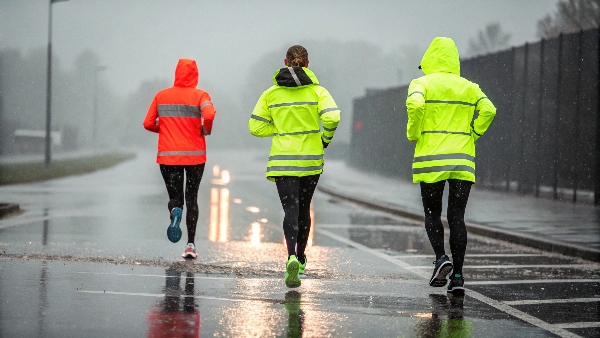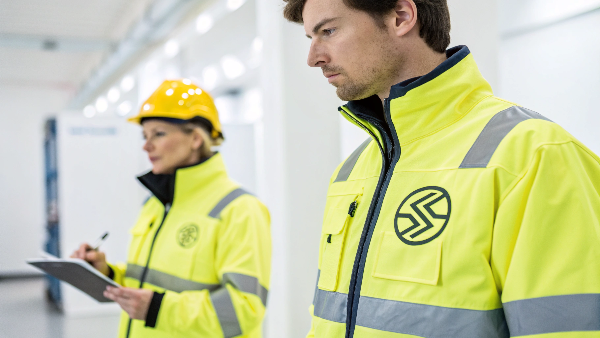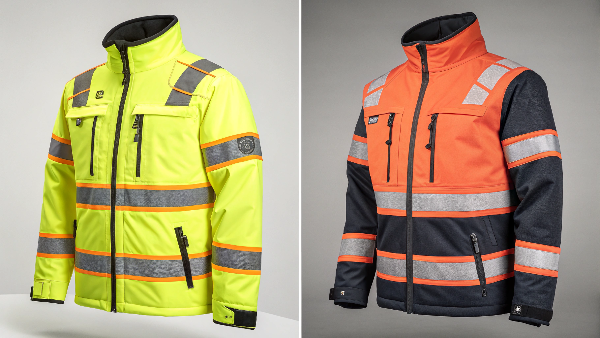Running at night is great, but drivers might not see you. This is risky. You need the right gear to stay visible and safe.
To be clearly visible when running at night, you should wear bright, reflective clothing and use lights. A headlamp or LED lights, combined with gear featuring reflective strips, significantly boosts your visibility to others.
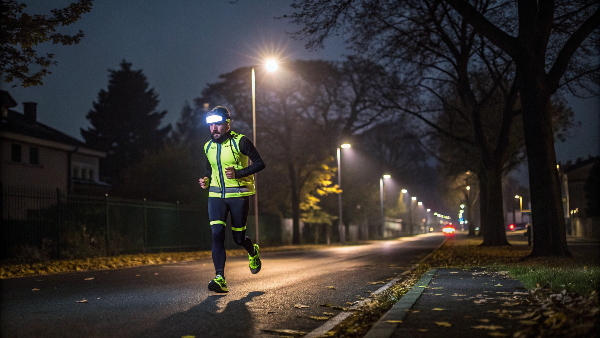
Staying safe during nighttime runs is a big concern for many runners I talk to. You want the freedom of running when it suits you, but not at the cost of your safety. Luckily, there are many straightforward ways to make yourself much more visible. As someone who's been in the personal protective equipment (PPE) business for over 25 years, I've learned a lot about what makes visibility gear effective, and I work closely with manufacturers like Vissafetywear who are experts in producing high-quality reflective apparel. Let's explore how you can stay safe and seen.
How can I be easily spotted when running after dark?
You enjoy evening runs, but darkness makes you nearly invisible. This can lead to dangerous close calls. Use specific strategies to light yourself up.
The best way to be spotted is by using a combination of reflective materials1 on your clothing and active light sources2 like LED armbands or a headlamp. This dual approach ensures you're seen.
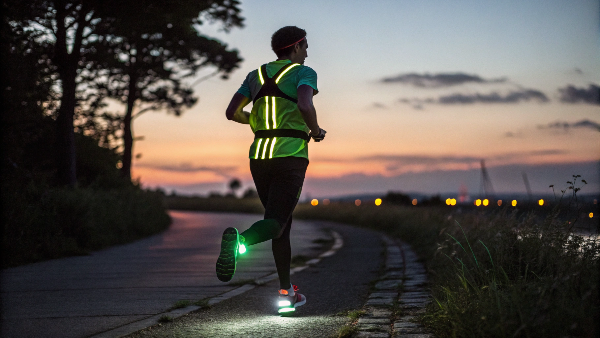
When I advise clients on safety gear, whether for professional use or recreational activities like running, the core principle is always conspicuity3 – how well you stand out from your surroundings. For night running, this means thinking about how light interacts with what you're wearing. Passive visibility relies on reflective materials. These don't generate light themselves, but they bounce back light from external sources, like car headlights. Think of it like this: the brighter the light hitting the reflective surface, the brighter you appear. High-quality reflective tapes, like those meeting EN ISO 20471 or ANSI/ISEA 107 standards (which Vissafetywear uses in their professional gear), are designed to return a large percentage of light directly to its source. Active visibility, on the other hand, involves wearing something that produces its own light, such as a headlamp or flashing LED bands. This is crucial in areas with no streetlights or for making you noticeable even when no headlights are pointing your way. I always recommend a mix; for example, a reflective vest combined with a small, blinking LED light clipped to your waistband or shoe.
| Visibility Method | How It Works | Key Benefit |
|---|---|---|
| Reflective Clothing | Bounces external light back to the source | Visible when illuminated by headlights |
| LED Lights (Active) | Emits its own light | Visible even in complete darkness, attracts attention |
| Bright/Fluorescent Base | Enhances visibility in low light (dusk/dawn) | Better general daytime and twilight visibility |
How can I make sure I'm seen when walking at night?
Evening walks are relaxing, but you worry about not being seen by cars. This can make you feel unsafe. Simple gear choices make a big difference.
For walking at night, wear light-colored or fluorescent clothing with reflective accents. Carrying a flashlight or using clip-on LED lights will also significantly improve your visibility to drivers and cyclists.
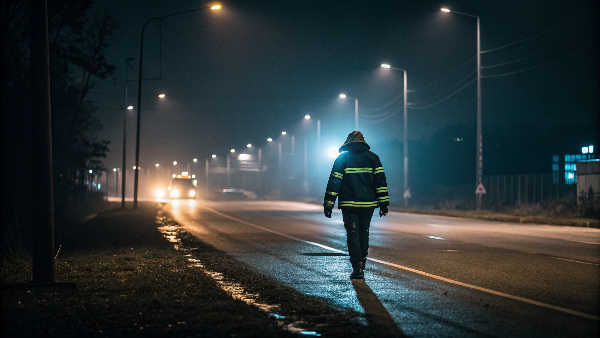
Walking at night shares many visibility challenges with running, but the pace difference might influence some gear choices. Since walkers are moving slower, they might be in a driver's field of vision for a slightly longer period, but this doesn't reduce the need to be highly visible. I often tell people that the same principles we apply to high-visibility workwear at Vissafetywear – strategic placement of reflective material and bright base colors – are just as important for a leisurely evening stroll. Consider a lightweight jacket with reflective piping or panels. Even accessories can contribute. A reflective hat or gloves can catch a driver's eye because these are moving body parts. If you walk with a bag, choose one with reflective elements or add reflective stickers. Using a small flashlight not only helps you see your path but also makes you more noticeable to others. The key is to think about visibility from all angles – front, back, and sides – because you never know where a vehicle might approach from.
| Item for Walkers | Description | Key Visibility Feature |
|---|---|---|
| Reflective Jacket | Lightweight outerwear with reflective strips/panels | Full torso visibility |
| LED Clip-on Lights4 | Small, battery-operated flashing lights | Active light source, versatile placement |
| Flashlight | Handheld or head-mounted light source | Illuminates path and makes walker visible |
| Reflective Accessories | Hats, gloves, shoe clips with reflective parts | Highlights movement, adds extra points of light |
How do I best protect myself when running at night?
You want to run at night but are concerned about potential dangers. This can cause anxiety. Take multiple precautions to ensure your safety.
Protect yourself by being highly visible with reflective gear5 and lights. Also, run in familiar, well-lit areas6, tell someone your route, and carry a phone7 for emergencies.
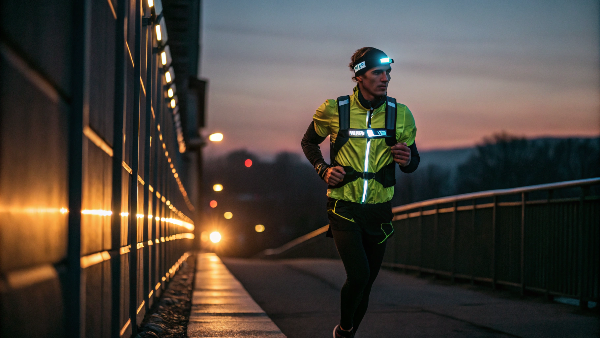
Visibility is a cornerstone of night running safety, but it's not the only piece of the puzzle. As someone who has sourced PPE for various industries for years, I understand that a comprehensive approach to safety is always best. First, as we've discussed, maximize your visibility. This is your first line of defense. Products like those Vissafetywear manufactures are designed for this very purpose. Beyond that, choose your route wisely. Stick to well-lit streets and paths that you are familiar with. Avoid dark, isolated areas, especially if you are running alone. It's also a good idea to vary your routes and times occasionally. Always let someone know where you are going and when you expect to be back. Carrying your phone is essential, not just for emergencies but also for tracking apps that can share your location in real-time. While some runners like music, be cautious with headphones; you need to hear approaching cars, cyclists, or other potential hazards. If you do use them, keep the volume low or use only one earbud.
| Night Running Safety Action | Reason | Priority |
|---|---|---|
| Wear Reflective/Lit Gear | Makes you visible to traffic and others | High |
| Choose Safe Routes | Reduces risk of trips, encounters, getting lost | High |
| Inform Someone | Ensures someone knows your whereabouts | High |
| Carry a Phone | For emergencies, communication, tracking | High |
| Be Aware of Surroundings | Helps you react to unexpected situations | Medium |
What are effective ways to make myself visible at night?
You need to be seen in the dark for various activities. Not being visible is a constant worry. Combine reflective elements and active lighting.
To make yourself visible at night, wear clothing with high-quality retro-reflective materials. Also, use personal lighting like headlamps or flashing LED accessories to actively signal your presence.
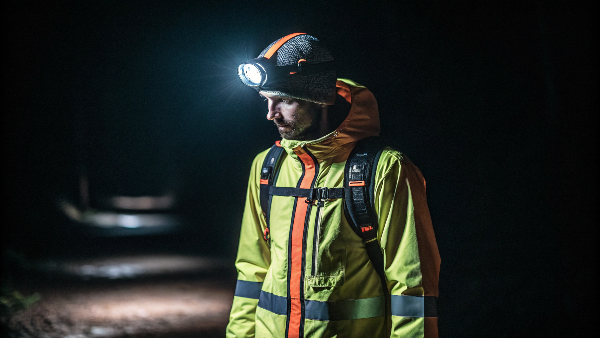
Making yourself visible at night isn't just for runners; it's crucial for anyone who's out and about after dark, whether you're cycling, walking your dog, or even dealing with a roadside emergency. The core strategies are quite universal. I always emphasize the importance of high-quality materials. For example, when Vissafetywear produces safety vests, they use reflective tapes that are certified to international standards. These tapes contain tiny glass beads or prisms that bounce light directly back towards the source, like a car's headlights. This is called retro-reflection, and it's incredibly effective. The placement of these reflective elements also matters. Having them on moving parts of your body, like your arms and legs, can attract more attention. Beyond reflective gear, active lighting is key. A bright headlamp not only illuminates your path but also makes you highly visible from the front. Small, blinking LED lights can be clipped almost anywhere – on your backpack, your belt, or even your pet's collar. The brighter and more distinct you are from the dark background, the safer you'll be.
| Visibility Strategy | How It Works | Example |
|---|---|---|
| Use Retro-Reflective Gear | Materials bounce light directly back to its source | Vests, jackets, pants with reflective strips |
| Employ Active Lighting | Wear devices that emit their own light | Headlamps, LED armbands, bike lights |
| Choose Bright Base Colors | Lighter colors reflect more ambient light than dark colors | Neon yellow, orange, or white clothing |
| Strategic Placement | Reflectors on moving body parts catch the eye | Ankle bands, wrist bands, shoe clips |
How can I ensure I am visible in the dark?
True darkness makes you feel completely unseen. This is a significant safety risk. Maximize contrast and use dedicated light sources.
To be visible in the dark, use high-contrast clothing with extensive reflective coverage and powerful personal lights. The goal is to stand out sharply against the unlit environment.
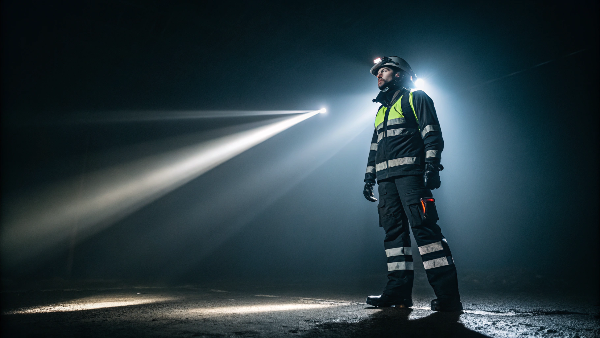
When we talk about being visible in "the dark," we often mean conditions with very little or no ambient light. In these situations, your ability to be seen depends almost entirely on what you wear and carry. I've seen firsthand through my work with Vissafetywear how critical the quality and amount of reflective material are. In truly dark conditions, a tiny reflective logo won't cut it. You need broad panels or multiple strips of high-grade retro-reflective tape, ideally offering 360-degree coverage. Think about how emergency responders' gear is designed – maximum visibility from every angle. The color of your clothing underneath the reflective elements also plays a role; lighter, brighter colors provide better contrast if there's any incidental light. However, active light sources become paramount in deep darkness. A strong headlamp not only lights your way but announces your presence from a distance. Flashing LED lights are particularly effective at grabbing attention because the human eye is drawn to blinking or moving lights. Remember, in the dark, you are competing against a black backdrop; your aim is to be the brightest thing a driver or cyclist sees.
| Visibility Aid | Pro | Con |
|---|---|---|
| High-Quality Reflective | Very bright when hit by light, no batteries needed | Only works when light shines on it |
| Active LED Lights | Visible in all conditions, attracts attention | Requires batteries/charging, can be small |
| Bright Base Fabric | Good for dusk/dawn, general visibility | Less effective in total darkness alone |
| Strategic Light Placement | Makes movement obvious, 360-degree options | Can require multiple units for full effect |
What can increase my ability to actually see when it's dark?
It's not just about being seen; you also need to see where you're going. Poor night vision is a hazard. Use appropriate lighting and allow your eyes to adjust.
Increase your ability to see at night by using a good quality headlamp. Also, give your eyes time to adapt to the darkness and choose routes with some ambient lighting if possible.
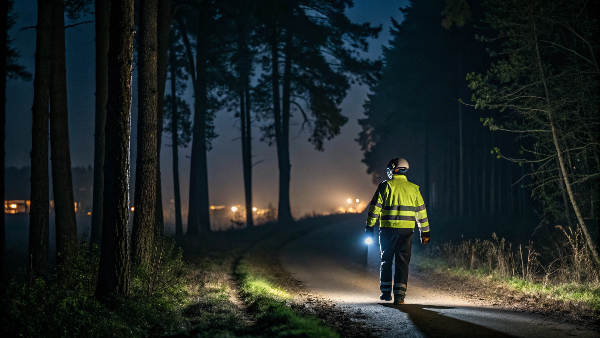
While much of our focus is on making you visible to others, your own ability to see clearly at night is just as important for safety. Tripping over an unseen obstacle or misjudging a curb can lead to injuries. The most direct way to improve your night vision is with a headlamp. When I source equipment, I look at features like lumens (brightness), beam pattern (flood vs. spot), and battery life. For running, a headlamp with a moderate lumen output (e.g., 100-300 lumens) is often sufficient to illuminate the path ahead without being blinding. Some headlamps offer different modes, allowing you to adjust brightness or switch to a red light, which is less disruptive to your night vision if you need to stop and check something. Another tip is to allow your eyes to adapt. It can take 15-30 minutes for your eyes to fully adjust to low-light conditions, so try to avoid looking at bright phone screens right before or during your run. If possible, pick routes that have some level of street lighting, as this reduces the strain on your eyes and your headlamp.
| Method to Enhance Night Vision | Detail | Benefit for Runner |
|---|---|---|
| Use a Quality Headlamp | Choose appropriate lumens, beam type, and comfortable fit | Illuminates path, helps identify obstacles |
| Allow Eye Adaptation | Avoid bright lights before/during run; give eyes time to adjust | Improves natural ability to see in low light |
| Choose Well-Lit Routes | Opt for streets/paths with existing lighting where safe and practical | Reduces reliance on headlamp, provides better overall vision |
| Keep Eyewear Clean | Ensure glasses or contacts are clean for optimal clarity | Prevents distorted or reduced vision |
How can I be more visible when biking at night?
Cycling at night presents unique visibility challenges. Cars might not see you from the side or rear. Use bike-specific lights8 and reflective gear.
For biking at night, use bright front and rear bike lights as legally required. Also, wear reflective clothing9 and add reflectors to your bike's frame, wheels, and pedals for maximum visibility.

Cycling at night requires a robust approach to visibility, often more so than running, due to higher speeds and different traffic dynamics. In my experience sourcing safety equipment, I know that cyclists need to be seen from all angles, especially from the front, rear, and sides. Legally, most places require a white front light and a red rear light on your bicycle after dark. These are non-negotiable. I always advise getting the brightest lights you can afford, especially for the rear, as this is what drivers approaching from behind will see. Flashing modes can increase conspicuity. Beyond lights on the bike, the cyclist's attire is crucial. A reflective jacket or vest, similar to what Vissafetywear makes for roadside workers, is highly effective. Reflective ankle bands are excellent because the pedaling motion creates a lot of movement, attracting the eye. Many bikes come with some reflectors, but you can always add more: to the spokes, the frame, and even your helmet. The goal is to create a "light signature10" that is unmistakably a cyclist.
| Bike Visibility Component | Placement | Importance |
|---|---|---|
| White Front Light | Handlebars or fork | Illuminates path, makes you visible head-on |
| Red Rear Light | Seatpost or rear rack | Essential for being seen by traffic from behind |
| Reflective Clothing | Jacket, vest, leg/arm bands | Makes the rider's body highly visible |
| Bike Reflectors | Wheels (spokes), pedals, frame (front/rear) | Provides passive visibility from multiple angles |
| Helmet Light/Reflectors | On the helmet | Higher vantage point for light/reflection |
Conclusion
In short, combining reflective gear with active lights is the best way to stay visible and safe when active at night.
-
Explore this link to discover top reflective materials that enhance your visibility during night runs, ensuring your safety. ↩
-
Check out this resource to find effective active light sources like LED armbands and headlamps that keep you visible in the dark. ↩
-
Learn more about conspicuity strategies to enhance your safety during night runs and avoid dangerous situations. ↩
-
Learn how LED Clip-on Lights can significantly boost your visibility and safety during evening strolls. ↩
-
Explore this link to discover top-rated reflective gear that enhances your visibility and safety during night runs. ↩
-
Understanding the significance of well-lit areas can help you choose safer routes and avoid potential dangers while running at night. ↩
-
Learn how having a phone can be a lifesaver during night runs, providing emergency contact and tracking capabilities. ↩
-
Explore this link to find top-rated bike lights that enhance your visibility and safety while cycling at night. ↩
-
Learn how reflective clothing can significantly increase your visibility and safety during nighttime rides. ↩
-
Discover the concept of a light signature and how it can help you be seen better while biking at night. ↩

